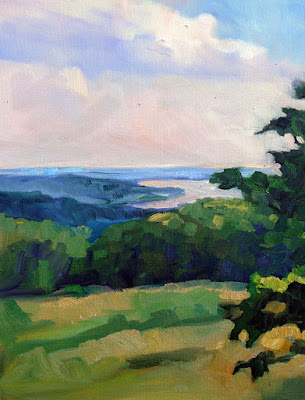 |
| My painting for ABVI’s “Play It Forward.” I know how to defeat this painting for next time I’m asked, BTW. |
When last I posted, I had just painted with my fellow
NYPAP artists* at
Olana, the home of
Frederic Edwin Church. This event, spearheaded by
Marilyn Fairman, is in honor of NYPAP’s founder, Ted Beardsley, who was the driving force who brought painters from all corners of our state together.
Last year, I left in the late afternoon, since I had to drive back to Rochester. I remember thinking, “It’s nice and I’ll come again, but I am not in love with the views.” (My feelings about grandiose historic homes are generally mildly negative; I mostly thank God I don’t have to maintain them.)
 |
| The Catskills are just so beautiful! |
This year, I was near the house as evening approached and I suddenly understood the magic of Olana: it is organized around the evening sky. The colors Church caught in his
Cotopaxipaintings are really no more magnificent than those he saw many evenings from his porch. Suddenly, as so often happens, my whole view of Church has undergone a sea change and I find myself studying his pinks and reds and considering them not as fantastical but as totally realistic.
But I—wretched creature that I am—had ignored
Jamie Grossman’s warning that I didn’t want to paint though the whole day, and I had nary an ounce of energy to paint that fantastic, fantastic sunset.
 |
| This year’s waterfall painting… not a success. Last year’s is here. |
The next day, many of us gathered at Jamie’s to paint waterfalls. Breakfast and then a brisk walk with friends, and I climbed down to the catchpool and set up. I was cautiously optimistic about this painting, since I’d painted a similar view last year with great success. Alas, it was not to be. Sometimes the mind is willing but the body is weak. I had a hard time concentrating; it was excessively hot; I was already tired and sore from a long day painting the day before. To cap it off I slipped on wet rocks and took a tumble.
But sometimes we are called away from man’s work to God’s work. I was asked a question I never hear in art circles: what does it mean to be ‘born again’? I did my best to answer, and all the way home to Rochester I second-guessed my answers, until I finally realized I am only here to play a very small part in an eternal duet between God and another soul.
 |
| I’m never happier than when teaching… |
Back to Rochester: Saturday morning promised another hot day, but we met on the canal at Schoen Place, where there was shade and a breeze. It wasn’t a brilliant painting day for any of us, but I’m never happier than surrounded by students and it was no exception.
 |
| My tiny landscape of canal path near Schoen Place. I hate wee brushes; can you tell? |
But Saturday evening turned out to be one of the weirder days of my art career. I had agreed to paint live at ABVI’s
“Play It Forward” event, not realizing that I was actually going to paint indoors at a cocktail party. Well, I’m game for anything, but it was a tough challenge. I duly finished the painting and it was sold for a decent price, and we all went home happy. And when I got in, my husband told me I’d missed one of the worst electrical storms he’d ever experienced. Good thing I was indoors!
Once again, thank you so much, Jamie Grossman, for your hospitality this week. It means more than I can express.
*Remember, NYPAP painters: you have a special discount at my Maine workshops… just for being you. August and September are sold out for my workshop at Lakewatch Manor in Rockland, ME… and the other sessions are selling fast. Join us in June, July and October, but please hurry! Check here for more information.








